Abstract
Acoustic emission technology relies on detecting and converting elastic (acoustic) waves from solids undergoing internal structural irreversible changes into electrical signals. This technique represents a non-destructive testing method used in industrial fields such as weld monitoring, proof testing, and flaw detection of pressure vessels. In this study, the applicability of acoustic emission technology for detecting and monitoring defects in a workpiece during a metal forming process was studied. A notch shape was designed using the finite element method to induce a premature crack on the surface of aluminum alloy cylindrical specimens by compressing them using a pair of flat dies. During the upsetting tests, acoustic emission signals and images of the notched specimen were recorded in real time. The obtained acoustic emission signals were analyzed through various parameters such as amplitude, energy, and RMS to determine the crack occurrence. Moreover, the signal results were compared with those from images obtained simultaneously to confirm the crack detection. The experimental results showed that acoustic emission technology could successfully detect crack occurrence in aluminum materials during the upsetting tests. These results imply an opportunity to detect material defects during various metal forming processes using acoustic emission technology.















Similar content being viewed by others
References
Hinz L, Kästner M, Reithmeier E (2019) Metal forming tool monitoring based on a 3D measuring endoscope using CAD assisted registration. Sensors (Basel) 19:2084. https://doi.org/10.3390/s19092084
Hawryluk M, Ziemba J, Sadowski P (2017) A review of current and new measurement techniques used in hot die forging processes. Meas Control 50:74–86. https://doi.org/10.1177/0020294017707161
Li YJ, Ai CS, Men XH, Zhang CL, Zhang Q (2013) Research on-line monitoring technology for steel ball’s forming process based on load signal analysis method. Mech Syst Signal Process 36:317–331. https://doi.org/10.1016/j.ymssp.2012.10.013
Filice L, Ambrogio G, Micari F (2016) On-line control of single point incremental forming operations through punch force monitoring. CIRP Ann 55:245–248. https://doi.org/10.1016/S0007-8506(07)60408-9
Behrens B-A, Santangelo A, Buse C (2013) Acoustic emission technique for online monitoring during cold forging of steel components: a promising approach for online crack detection in metal forming processes. Prod Eng Res Devel 7:423–432. https://doi.org/10.1007/s11740-013-0452-8
Behrens BA, Bouguecha A, Buse C, Wölki K, Santangelo A (2016) Potentials of in situ monitoring of aluminum alloy forging by acoustic emission. Arch Civ Mech Eng 16:724–733. https://doi.org/10.1016/j.acme.2016.04.012
Behrens BA, Hübner S, Wölki K (2017) Acoustic emission—a promising and challenging technique for process monitoring in sheet metal forming. J Manuf Processes 29:281–288. https://doi.org/10.1016/j.jmapro.2017.08.002
El-Galy I, Bernd-Arno B (2008) Online monitoring of hot die forging processes using acoustic emission (Part I). J Acoust Emissions 26:208–218
Martínez González E, Picas Anfruns I, Casellas Padró D, Romeu Garbí J (2010) Analysis of fracture resistance of tool steels by means of acoustic emission. In: 29th Eur Conf Acoust Emission Testing, p 1–7
Seemuang N, Panich S, Slatter T (2018) Crack initiation detection in JAC780Y during tensile loading by using direct current potential drop and acoustic emission techniques. Int J Mech Eng Robot Res 7:348–352. https://doi.org/10.18178/ijmerr.7.4.348-352
Carpinteri A, Lacidogna G, Pugno N (2007) Structural damage diagnosis and life-time assessment by acoustic emission monitoring. Eng Fract Mech 74:273–289. https://doi.org/10.1016/j.engfracmech.2006.01.036
Scruby CB (1987) An introduction to acoustic emission. J Phys E: Sci Instrum 20:946–953. https://doi.org/10.1088/0022-3735/20/8/001
Terchi A, Au YHJ (2001) Acoustic emission signal processing. Meas Control 34:240–244. https://doi.org/10.1177/002029400103400804
Wu BS, McLaskey GC (2018) Broadband calibration of acoustic emission and ultrasonic sensors from generalized ray theory and finite element models. J Nondestruct Eval 37:8. https://doi.org/10.1007/s10921-018-0462-8
Scott IG (1991) Basic acoustic emission. CRC Press, 6
Moradian Z, Li BQ (2017) Hit-based acoustic emission monitoring of rock fractures: challenges and solutions. Springer Proc Phys 179:357–370. https://doi.org/10.1007/978-3-319-29052-2_31
Lee SG Nondestructive testing and applications for integrity assessment of power plant facilities by acoustic emission technology-part 1: the theory of acoustic emission technology (I). J Korea Soc Power Syst Eng, 9 2205:5–13
Grosse CU, Ohtsu M (2008) Acoustic emission testing. Springer Sci Bus Media
Filippov AV, Rubtsov VE, Tarasov SY (2017) Acoustic emission study of surface deterioration in tribocontacting. Appl Acoust 117:106–112. https://doi.org/10.1016/j.apacoust.2016.11.007
Wang C, Bao Z, Zhang P, Ming W, Chen M (2019) Tool wear evaluation under minimum quantity lubrication by clustering energy of acoustic emission burst signals. Measurement 138:256–265. https://doi.org/10.1016/j.measurement.2019.02.004
Poláková I, Zemko M, Rund M, Džugan J (2020) Using DEFORM software for determination of parameters for two fracture criteria on DIN 34CrNiMo6. Metals 10(4):445. https://doi.org/10.3390/met10040445
Funding
This work was supported by the Technology Innovation Program (20011678, Manufacture and application technology development of tensile strength 1,000 MPa non-Heat treatment ball stud at low cost); Ministry of Trade, Industry & Energy (MOTIE, Korea); and the Fundamental Research Program of the Korea Institute of Materials Science (PNK7310, KIMS).
Author information
Authors and Affiliations
Corresponding author
Ethics declarations
Ethics approval
Not applicable.
Consent to participate
Not applicable.
Consent for publication
Not applicable.
Conflict of interest
The authors declare no competing interests.
Additional information
Publisher's note
Springer Nature remains neutral with regard to jurisdictional claims in published maps and institutional affiliations.
Rights and permissions
Springer Nature or its licensor (e.g. a society or other partner) holds exclusive rights to this article under a publishing agreement with the author(s) or other rightsholder(s); author self-archiving of the accepted manuscript version of this article is solely governed by the terms of such publishing agreement and applicable law.
About this article
Cite this article
Ha, M., Kim, J.H. & Kim, S. Crack detection in upsetting of aluminum alloy using acoustic emission monitoring technology. Int J Adv Manuf Technol 124, 2823–2834 (2023). https://doi.org/10.1007/s00170-022-10628-y
Received:
Accepted:
Published:
Issue Date:
DOI: https://doi.org/10.1007/s00170-022-10628-y




